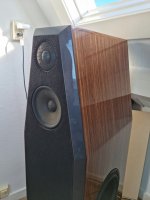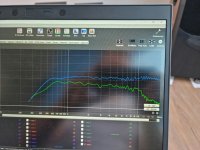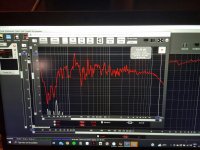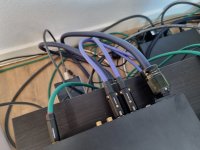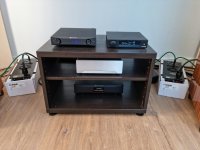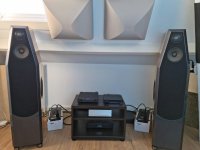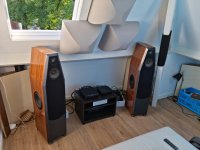It's been almost three years since I broke down my last system to start building this. Building the cabinets and getting them finished like this took almost half a year. The project also was on hold for a long time because I lived somewhere else for a year and also saving money and acquiring all the gear took a long time. This summer vacation I moved back in with my parents and finally got back to it. I made got the last cables and did all the finishing touches to the speakers, measuring and tuning just last week.
Speakers:
-H: BliesMa T34B-4
-M: SB-Acoustics Satori MR16P-4
-L: 2 × SB-Acoustics Satori WO24P-8
System:
Source: MiniDSP SHD Studio
DAC: NuPrime DAC-9SE
Amps:
-H: Purifi EVAL-1
-M/L: Hypex FA502
Netfilters: NuPrime AC-4
Cabling: all DIY Furutech power and interconnects, Sharkwire Musical Love speaker cables (int. and ext.).
It's an active DSP controlled system. The MiniDSP is a network streamer with on-board DSP with two digital outputs. One feeds through the NuPrime DAC into the Purifi amp which powers just the tweeters. The other output goes into the master Hypex amp which feeds through to the slave. One channel of each amp powers the midrange, the other the woofers. Yes the power figures are absolutely stupid. 400 Watts for each tweeter, 500 Watts for each midrange and 500 Watts for each pair of woofers. I absolutely don't need all this power but I wanted to use a very high quality amp for the tweeters which the Purifi most definately is. And it just happens to be 400 Watts. I did purposely choose the biggest FusionAmp model because they are a lot quieter. All this excessive power is a nice thing anyway because the system can perform while Amps are always at ease playing with low distortion and great control.
The speakers are made out of 25 mm HDF. I designed them in CAD and got all the panels CNC cut. The inside of the sealed bass enclosure is reinforced by 8 internal panels which are placed pointing away from the centre of the opposed woofers. This way the woofers cancel each others forces and the cabinet stays completely quiet at any volume.
The midrange chamber is the entire trapeze shaped part. A very large volume so that the midrange can move completely free. There are no braces in the midrange chamber. Instead the sides are reinforced by 10 mm aluminum plates pressed against the HDF with bitumen and a rubbery adhesive in-between. This way the side panels are extremely rigid and quite well damped and there are no reflective surfaces right behind the midrange. Internally the back of the midrange chamber is triangular which together with the slanted sides goes against standing waves. It's also stuffed with natural wool. The bass cabinets are stuffed with Knauf Acoustifit. The speakers sit on IsoAcoustics Gaia II damping feet (they are right on the weight limit 😅).
The trapezoid top together with the bevelled edges and felt lined baffle work greatly to make on- and off-axis response very smooth with little defraction and baffle reflections. And I have to say I was quite proud of myself when I saw the first measurments (these were done in the living room not in this small space). The red graph is a RTA measurment after time alignment. The lower frequencies are obviously bumpy in the measurment but the mid and high frequencies were already very smooth IMO. The blue line is on axis gated measurment after just a few tweaks in the EQ. Maybe a little bright but this was just a base. Green is ~60⁰ off-axis. I was also very impressed by the linearity off-axis. No real big peaks or dips even very far off-axis. Crossover frequencies are 250 Hz and 2,6 kHz.
After the speakers were reasonable flat I set up the system in my room, redid the time alignment on the listening position and decided the toe-in angle so that the sound disconnects from the speakers so the soundstage goes wider than the speakers. Then I finished up the tuning by Dirac Live calibration on the MiniDSP. Wow does that save a lot of time and wow does it give magnificent results. This is the way I will forever calibrate my speakers.
The electronics don't have many hours on them yet but it's no problem.
The sound is incredible. Exactly what it was among for. The lows are probably the tightest and most linear I have ever heared. And the go all the way down. I set Dirac to EQ them flat (-0 dB not -3 dB) down to 17 Hz and I know these speakers are capable of that and it shows. While playing hard techno I think the bass packs a much harder hitting punch with these bigger amplifiers than i remember from before. Mid's are very free with great clarity and body. That paper Satori just sounds so wonderfully organic/natural and that big chamber with proper damping really let's it sing unrestricted.
The driver that really shines though is the tweeter. This beryllium BliesMa is with no doubt the best dome tweeter on the market. Before this I had the SB-Acoustics Satori TW29BN. Already one of the top beryllium tweeters on the market. This BliesMa is on a whole other level in terms of speed, detail and soundstaging. I'm not exaggerating when I say it is a night and day difference. I did get to compare the difference when I already tried them in the last speakers.
All together the sound is very complete. Obviously extremely linear. Very fast transient response and tightness from top to bottom. Extremely low distortion. Great naturality and body. And most impressive are the tremendously deep and wide soundstage and the absurd detail. There is not a sound in any recording that can hide. I'm hearing things I didn't even hear before on my previous system or Campfire Holocene IEM's with iFi Gryphon DAC. I'll put this system up against any system up to €100k.
I'm gonna be satisfied for a long time.
Speakers:
-H: BliesMa T34B-4
-M: SB-Acoustics Satori MR16P-4
-L: 2 × SB-Acoustics Satori WO24P-8
System:
Source: MiniDSP SHD Studio
DAC: NuPrime DAC-9SE
Amps:
-H: Purifi EVAL-1
-M/L: Hypex FA502
Netfilters: NuPrime AC-4
Cabling: all DIY Furutech power and interconnects, Sharkwire Musical Love speaker cables (int. and ext.).
It's an active DSP controlled system. The MiniDSP is a network streamer with on-board DSP with two digital outputs. One feeds through the NuPrime DAC into the Purifi amp which powers just the tweeters. The other output goes into the master Hypex amp which feeds through to the slave. One channel of each amp powers the midrange, the other the woofers. Yes the power figures are absolutely stupid. 400 Watts for each tweeter, 500 Watts for each midrange and 500 Watts for each pair of woofers. I absolutely don't need all this power but I wanted to use a very high quality amp for the tweeters which the Purifi most definately is. And it just happens to be 400 Watts. I did purposely choose the biggest FusionAmp model because they are a lot quieter. All this excessive power is a nice thing anyway because the system can perform while Amps are always at ease playing with low distortion and great control.
The speakers are made out of 25 mm HDF. I designed them in CAD and got all the panels CNC cut. The inside of the sealed bass enclosure is reinforced by 8 internal panels which are placed pointing away from the centre of the opposed woofers. This way the woofers cancel each others forces and the cabinet stays completely quiet at any volume.
The midrange chamber is the entire trapeze shaped part. A very large volume so that the midrange can move completely free. There are no braces in the midrange chamber. Instead the sides are reinforced by 10 mm aluminum plates pressed against the HDF with bitumen and a rubbery adhesive in-between. This way the side panels are extremely rigid and quite well damped and there are no reflective surfaces right behind the midrange. Internally the back of the midrange chamber is triangular which together with the slanted sides goes against standing waves. It's also stuffed with natural wool. The bass cabinets are stuffed with Knauf Acoustifit. The speakers sit on IsoAcoustics Gaia II damping feet (they are right on the weight limit 😅).
The trapezoid top together with the bevelled edges and felt lined baffle work greatly to make on- and off-axis response very smooth with little defraction and baffle reflections. And I have to say I was quite proud of myself when I saw the first measurments (these were done in the living room not in this small space). The red graph is a RTA measurment after time alignment. The lower frequencies are obviously bumpy in the measurment but the mid and high frequencies were already very smooth IMO. The blue line is on axis gated measurment after just a few tweaks in the EQ. Maybe a little bright but this was just a base. Green is ~60⁰ off-axis. I was also very impressed by the linearity off-axis. No real big peaks or dips even very far off-axis. Crossover frequencies are 250 Hz and 2,6 kHz.
After the speakers were reasonable flat I set up the system in my room, redid the time alignment on the listening position and decided the toe-in angle so that the sound disconnects from the speakers so the soundstage goes wider than the speakers. Then I finished up the tuning by Dirac Live calibration on the MiniDSP. Wow does that save a lot of time and wow does it give magnificent results. This is the way I will forever calibrate my speakers.
The electronics don't have many hours on them yet but it's no problem.
The sound is incredible. Exactly what it was among for. The lows are probably the tightest and most linear I have ever heared. And the go all the way down. I set Dirac to EQ them flat (-0 dB not -3 dB) down to 17 Hz and I know these speakers are capable of that and it shows. While playing hard techno I think the bass packs a much harder hitting punch with these bigger amplifiers than i remember from before. Mid's are very free with great clarity and body. That paper Satori just sounds so wonderfully organic/natural and that big chamber with proper damping really let's it sing unrestricted.
The driver that really shines though is the tweeter. This beryllium BliesMa is with no doubt the best dome tweeter on the market. Before this I had the SB-Acoustics Satori TW29BN. Already one of the top beryllium tweeters on the market. This BliesMa is on a whole other level in terms of speed, detail and soundstaging. I'm not exaggerating when I say it is a night and day difference. I did get to compare the difference when I already tried them in the last speakers.
All together the sound is very complete. Obviously extremely linear. Very fast transient response and tightness from top to bottom. Extremely low distortion. Great naturality and body. And most impressive are the tremendously deep and wide soundstage and the absurd detail. There is not a sound in any recording that can hide. I'm hearing things I didn't even hear before on my previous system or Campfire Holocene IEM's with iFi Gryphon DAC. I'll put this system up against any system up to €100k.
I'm gonna be satisfied for a long time.
Attachments
Last edited:
I like the subwoofer. Invisible design 👍
The sub works great with 4 x 6.5 inch down firing woofers, just refoamed them and until now nobody thnks it is a sub 🤣 It integrates perfect about speed a phase with the main speakers, runs 40 Hz and down..
The requirement: An Active 4 way stereo direct radiating speaker system which could be used for music as also casual home cinema speakers duty. Now before you judge me and say an immersive cinema experience can only be had with dedicated surrounds, Centre, and satellites, etc., please understand the idea was to install it in a small to medium sized room with a couple of lounging chairs and a book shelf plus a large screen television to be used as a den without carrying the whistles of a full fledged home theatre. There would be reasonable wall paddings and diffusers installed at places, would not be a completely dark room (need regular reflections of light for a relaxing environment), not completely cut off from the main living areas. Which means sound would reflect somewhat and it will not be an acoustic room. Most homes have such a room which can be thus easily turned into a relaxation area. This would of course present its difficulties in tuning the system and ensuring the coloration is manageable with minimum phase/timing corrections. There would be further be a glass window and some hard reflective surfaces, and the turning would be an exercise in itself.
Further requirements: A high spl, high wattage, and a large radiating surface, which means either large woofers (15/18 inches) or multiple drivers doing sub/low frequency duty. The path after the media was to be completely analogue to make way for the system to be used with a turntable if required. The outward appearance was to be rectangular and separate units for sub-woofers and the rest of the 3 way for easy shifting, and also separate units would enable several combinations to be tried depending upon the room size, music preference, etc.
Wife acceptance factor: This could never be a winner in this department but still had to be of a reasonable footprint to not be completely out of place in room sizes 200 square feet or more.
The costs: To be kept under $ 5k. Now of course the first set would involve a lot of man hours and iterations but subsequent systems could be built under $ 5k overall.
Driver selection:
Sub bass: 4*8” subwoofers capable of minimum 150 watts rms per piece to be run with a 600 watts amplifier per side. The driver was manufactured by a local manufacturer near Delhi in India. Since 4 were to be used each side and driven at relatively high wattage and equalized to the extra radiating area would compensate for low efficiency and a fairly decent fs in the low forties with a port tuned to below 30 hz would cover the entire spectrum from below 30 to up to 200 hz, depending upon the active equalisation applied. For new recordings either digitally produced or with lots of instruments, this would be a low pass at around 80/100 hz, and for old recordings with nothing below 40 hz to hear and vocals between 80-200 hz requiring a higher thrust, the low pass would be placed higher between 140-200 hz. Here is a photo of the driver- the impedance graph and the parameters are in an attached pdf file.
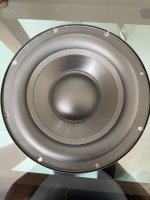
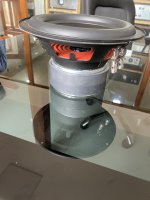
Bass/Mid bass: Frequencies up to 450 hz- Celestion 8 inches FTR-08- 2011D. These show an extremely flat response from 100 hz- 3000 hz in a sealed box based and was perfect for the job. I only needed it to play between 100-450/700 hz and these do wonderful duty in this range. I have used these extensively between 70-5k hz and they have become my favourite mid drivers. The depth in the vocals is extremely pleasing with these drivers.
Tweeter: A Peerless Tymphany D27TG35-01 1” silk tweeter has always been my favourite, partly because these are easily available in India, and are the most forgiving with below par crossovers and are at home equalise anywhere from 2.2 hz and above.
Mid range: I had a variety of speakers to do duty between 450/700 hz to 2.3/3.3khz and chose a well built pro inexpensive 8” driver with a low xmas owing to a stiff surround but a very light wool mixed composite paper cone (again from my local manufacturer in Delhi). The alternative was the Celestion TFO510 (I have an affinity towards Celestion pro drivers) and either of these worked very well, with some listeners gravitating towards the Celestion and some including me over the 8 inch driver.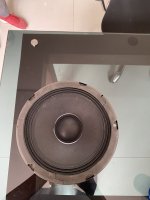
The cabinets: Two cabinets were built with similar width to keep on top of each other, for a homogenous radiating area. Both were built in two layers using 19mm medium density fibre board, and diffusers made of same material and wool felt lining the walls inside. The diffusers were cut into curved small pieces to somehow make the cabinets believe they were not rectangular, to try to fool the standing waves not to color the music to unacceptable levels. The subwoofer cabinets have bracing lined up on the corners and between each driver, and measure 13.25”*18.75”*47.25” to achieve slightly less than 4 cubic feet internal volume overall, and further lined with polyfil with 0.25 inches layers one at a time to assess the optimum fill levels, which was arrived at 3 layers eventually. Two ports of 3.5 inches clear diameter with minimal flairs and 8.5” long are used at the bottom and tuned to 29 hz.
Each driver has its own 1” baffle grinded into a slope to meet the edge of the membrane. Below which the drivers are surface mounted. This has somewhat met the criteria of lower baffle excitement on account of the large overall radiating area of 4 woofers together. The edges are rounded and perhaps serve a cosmetic purpose rather than any real diffusion.
The rest of the 3 way cabinet measures 13.25”*14.75”*23.75” and the midrange and the tweeter are in a separate enclosure within this enclosure. Though perhaps such a large cabinet was not needed since the Celestion mid woofer has a very low qts and requires but a small chamber sealed, the placement of the 3 speakers with internal partitions was not possible without this front profile. Measurement of this 3 way was taken separately both in an almost acoustically dead room and outside, and was found to be fairly flat from 100 hz above, at which frequency it is to be really used.
Crossover: Two units of DBX Linkwitz Riley 4th order each used mono 4 Way, with the general cut off points at 100hz, 450hz and 3.3khz. Being active a variety of slopes can be played around for each driver, which really gives a large latitude in arriving at a listener’s sweet spot according to the genre of music playing.
The media- A smart TV, a receiver, a dvd player, anything which has a pre-out.
The amplifiers: 8 channels of analogue class AB classic amplifier designs of no more than 3 stages with limited feedback custom assembled for these speakers. They are 600, 200, 200 and 100 watts each side, all with the Toshiba 5200/1943 topology.
Finish: These are finished in a high gloss veneer with a 7 coat polish, and automotive black paint, and if you will pardon the smudges of dirty hands here and there, they are quite pleasing to look at too.
The verdict: And there we have. I am blessed to have a couple of golden eared people who have auditioned these, not to mention a few audiophile friends, and a couple of hi-fi store owners, several other casual listeners and we have all found these extremely musical. Some including me have been so emotionally moved of the purity and resolution of music coming out of these speakers, that we find it difficult to move away once we have listened for an hour. The subwoofers are capable of producing quite deep rumbling notes in motion soundtracks, and the music otherwise appears very complete with no jarring notes. These are speakers perhaps of which I will not grow out of for a long time.
Here is a picture with a measurement through REW and a UMIk-2 microphone, the picture snapped straight off the laptop screen. The measurement below 200 hz should not be a benchmark- I find the bass too good despite the uneven lines, and the occasional dip around crossover points. A similar baffle placed on the top unit has been removed in this picture. The black mesh covering has been removed too.
Also see an image of another 3 way unit with a Peerless pro 8 inch driver as a mid bass instead of the Celestion, and a China import 6 inches doing the upper midrange duty in a triple cut baffle to separate the three drivers.
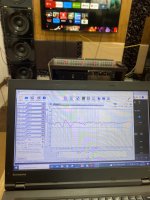
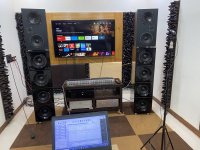
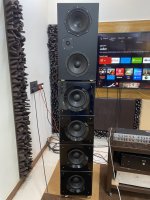


Further requirements: A high spl, high wattage, and a large radiating surface, which means either large woofers (15/18 inches) or multiple drivers doing sub/low frequency duty. The path after the media was to be completely analogue to make way for the system to be used with a turntable if required. The outward appearance was to be rectangular and separate units for sub-woofers and the rest of the 3 way for easy shifting, and also separate units would enable several combinations to be tried depending upon the room size, music preference, etc.
Wife acceptance factor: This could never be a winner in this department but still had to be of a reasonable footprint to not be completely out of place in room sizes 200 square feet or more.
The costs: To be kept under $ 5k. Now of course the first set would involve a lot of man hours and iterations but subsequent systems could be built under $ 5k overall.
Driver selection:
Sub bass: 4*8” subwoofers capable of minimum 150 watts rms per piece to be run with a 600 watts amplifier per side. The driver was manufactured by a local manufacturer near Delhi in India. Since 4 were to be used each side and driven at relatively high wattage and equalized to the extra radiating area would compensate for low efficiency and a fairly decent fs in the low forties with a port tuned to below 30 hz would cover the entire spectrum from below 30 to up to 200 hz, depending upon the active equalisation applied. For new recordings either digitally produced or with lots of instruments, this would be a low pass at around 80/100 hz, and for old recordings with nothing below 40 hz to hear and vocals between 80-200 hz requiring a higher thrust, the low pass would be placed higher between 140-200 hz. Here is a photo of the driver- the impedance graph and the parameters are in an attached pdf file.


Bass/Mid bass: Frequencies up to 450 hz- Celestion 8 inches FTR-08- 2011D. These show an extremely flat response from 100 hz- 3000 hz in a sealed box based and was perfect for the job. I only needed it to play between 100-450/700 hz and these do wonderful duty in this range. I have used these extensively between 70-5k hz and they have become my favourite mid drivers. The depth in the vocals is extremely pleasing with these drivers.
Tweeter: A Peerless Tymphany D27TG35-01 1” silk tweeter has always been my favourite, partly because these are easily available in India, and are the most forgiving with below par crossovers and are at home equalise anywhere from 2.2 hz and above.
Mid range: I had a variety of speakers to do duty between 450/700 hz to 2.3/3.3khz and chose a well built pro inexpensive 8” driver with a low xmas owing to a stiff surround but a very light wool mixed composite paper cone (again from my local manufacturer in Delhi). The alternative was the Celestion TFO510 (I have an affinity towards Celestion pro drivers) and either of these worked very well, with some listeners gravitating towards the Celestion and some including me over the 8 inch driver.

The cabinets: Two cabinets were built with similar width to keep on top of each other, for a homogenous radiating area. Both were built in two layers using 19mm medium density fibre board, and diffusers made of same material and wool felt lining the walls inside. The diffusers were cut into curved small pieces to somehow make the cabinets believe they were not rectangular, to try to fool the standing waves not to color the music to unacceptable levels. The subwoofer cabinets have bracing lined up on the corners and between each driver, and measure 13.25”*18.75”*47.25” to achieve slightly less than 4 cubic feet internal volume overall, and further lined with polyfil with 0.25 inches layers one at a time to assess the optimum fill levels, which was arrived at 3 layers eventually. Two ports of 3.5 inches clear diameter with minimal flairs and 8.5” long are used at the bottom and tuned to 29 hz.
Each driver has its own 1” baffle grinded into a slope to meet the edge of the membrane. Below which the drivers are surface mounted. This has somewhat met the criteria of lower baffle excitement on account of the large overall radiating area of 4 woofers together. The edges are rounded and perhaps serve a cosmetic purpose rather than any real diffusion.
The rest of the 3 way cabinet measures 13.25”*14.75”*23.75” and the midrange and the tweeter are in a separate enclosure within this enclosure. Though perhaps such a large cabinet was not needed since the Celestion mid woofer has a very low qts and requires but a small chamber sealed, the placement of the 3 speakers with internal partitions was not possible without this front profile. Measurement of this 3 way was taken separately both in an almost acoustically dead room and outside, and was found to be fairly flat from 100 hz above, at which frequency it is to be really used.
Crossover: Two units of DBX Linkwitz Riley 4th order each used mono 4 Way, with the general cut off points at 100hz, 450hz and 3.3khz. Being active a variety of slopes can be played around for each driver, which really gives a large latitude in arriving at a listener’s sweet spot according to the genre of music playing.
The media- A smart TV, a receiver, a dvd player, anything which has a pre-out.
The amplifiers: 8 channels of analogue class AB classic amplifier designs of no more than 3 stages with limited feedback custom assembled for these speakers. They are 600, 200, 200 and 100 watts each side, all with the Toshiba 5200/1943 topology.
Finish: These are finished in a high gloss veneer with a 7 coat polish, and automotive black paint, and if you will pardon the smudges of dirty hands here and there, they are quite pleasing to look at too.
The verdict: And there we have. I am blessed to have a couple of golden eared people who have auditioned these, not to mention a few audiophile friends, and a couple of hi-fi store owners, several other casual listeners and we have all found these extremely musical. Some including me have been so emotionally moved of the purity and resolution of music coming out of these speakers, that we find it difficult to move away once we have listened for an hour. The subwoofers are capable of producing quite deep rumbling notes in motion soundtracks, and the music otherwise appears very complete with no jarring notes. These are speakers perhaps of which I will not grow out of for a long time.
Here is a picture with a measurement through REW and a UMIk-2 microphone, the picture snapped straight off the laptop screen. The measurement below 200 hz should not be a benchmark- I find the bass too good despite the uneven lines, and the occasional dip around crossover points. A similar baffle placed on the top unit has been removed in this picture. The black mesh covering has been removed too.
Also see an image of another 3 way unit with a Peerless pro 8 inch driver as a mid bass instead of the Celestion, and a China import 6 inches doing the upper midrange duty in a triple cut baffle to separate the three drivers.




Attachments
This is awesome. Can you provide some more details on the down firing 6.5inches woofers working as a sub- a fairly long single piece? These must really sound too good. And I think the midrange on the top is open baffle? Presumably the sound stage should be quite good with that.The sub works great with 4 x 6.5 inch down firing woofers, just refoamed them and until now nobody thnks it is a sub 🤣 It integrates perfect about speed a phase with the main speakers, runs 40 Hz and down..
Last edited:
Nice cut on the baffle and impeccable veneer(?) finish. I am impressed by the way you have described the internal mechanics of the enclosure regarding the two 8 inch woofers on the sides. I am sure a lot of guys (including me) would try something similar. I would be a bit careful with the 100k price point comparison- I once did a similar comparison to a Burnmester and was roasted asking to be compared side by side🙂It's been almost .......
All together the sound is very complete. Obviously extremely linear. Very fast transient response and tightness from top to bottom. Extremely low distortion. Great naturality and body. And most impressive are the tremendously deep and wide soundstage and the absurd detail. There is not a sound in any recording that can hide. I'm hearing things I didn't even hear before on my previous system or Campfire Holocene IEM's with iFi Gryphon DAC. I'll put this system up against any system up to €100k.
I'm gonna be satisfied for a long time.
Very impressive. Would be keen to understand how you got the wooden horns made. I live in India a couple of hundred miles off a city known for its woodwork, and recently a friend said he had got impressive horns handmade from a vendor there. Am itching to go to that vendor myself and in the meantime I see this beautiful attempt of yours 🙂I've attached photos of my speakers. They are horn type loudspeaker inspired by the Usher D2, Zingali loudspeakers, and the JBL K2 project (which became the JBL M9500).
When I built these, the Usher D2 used TAD TD-4001 compression drivers behind their wooden horns. HOWEVER, the latest Usher version, the D3, uses what they call "US-375" drivers. Anyone know the specs on these? Who is the manufacturer? Perhaps somehow related to the original JBL 375 drivers?
The TD-4001 is a tough act to follow, and Usher has not lowered their price on the D3.
Comments, anyone?
The bass is a Faital 15pr400 in a sealed enclosure of 90 liters.
The horn on top is a SEOS 24 with a Faital Hf1400, activ with xilica crossed, icepower ax125 in BTL for the bass and one anaview alc180 for the horns.
The horn on top is a SEOS 24 with a Faital Hf1400, activ with xilica crossed, icepower ax125 in BTL for the bass and one anaview alc180 for the horns.
I‘ve made a mistake, the driver is the Hf1440 not the Hf1400.
Some more pictures




Some more pictures
Thank you! They're 9,5" woofers actually. Yes the baffle with the felt in it turned out very nice indeed. Finishing was done by a company that restores vintage Riva speedboats.Nice cut on the baffle and impeccable veneer(?) finish. I am impressed by the way you have described the internal mechanics of the enclosure regarding the two 8 inch woofers on the sides. I am sure a lot of guys (including me) would try something similar. I would be a bit careful with the 100k price point comparison- I once did a similar comparison to a Burnmester and was roasted asking to be compared side by side🙂
I know comparing to 100k systems is a bold statement. But I've actually worked at a high end store in my city for half a year. They've got some of the nicer models Wilson, Vivid, KEF (the Blade is my favourite) and a selection of the exotic electronics including Dan D'Agostino, Zandèn an Mola Mola in house along with much more. I've got quite some hours with various systems including these components and I'm hearing details and nuances in some recordings that I can't recall ever having heared them like that. One of my former colleagues from there came over to listen and he agreed! I even demod the previous version in their listening room and everybody was impressed. And these new ones are a big improvement.
Attachments
Last edited:
3wayaddict, I don't doubt for a minute they would not sound better than a system of any value. The intrinsic value of the components (drivers, woodworking, crossover), etc never exceeds a fraction of the cost in the most expensive systems. Then comes the brand name and thereafter the perceived value through marketing, affiliations, etc. Some extremely expensive speakers claim multiple real time corrections and complex circuitry to create an aura of invincibility in sound reproduction. For me, so long as the basic principles of nature (physics?) have been followed, a well made speaker with adequate radiation area will sound the most musical. And like you, I also have personal experience now. Having auditioned the most expensive brands in showrooms, I decided going back to the basics to the bygone era where speakers were most musical with adequate cone areas and not so impeccable finishes, but somewhat honest pricing so the people at large could enjoy the God given gift of music to humanity. Just that I am now a bit careful to compare to an expensive product. If someone comes to me to audition I would let them decide for themselves. Usually an hour of listening to the best speakers I have is sufficient to make a capable listener realise what real music reproduction is all about. Most sensitive people leave as if in a trance once they have listened to these speakers for some time.
The used open cone midrange driver due to it's design can only be mounted on the rear of the baffle and also requires its own enclosed housing volume. That is why there is a separated chamber in the upper part of the box, that is accessible from the rear. The crossover is mounted on the lid. The whole thing also has the advantage for me that I can quickly get to the crossover to make changes and try them out. The loudspeakers were tuned by ear and initially, over time and after many different listening impressions, it sometimes became necessary to tweak the crossover slightly.I built another pair of my Stonehenge series, now "Stonehenge 4"
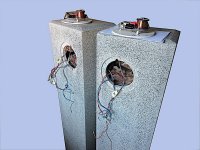
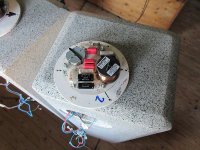
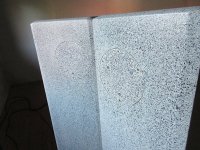
I agree! I too believe (and it's physics so it's quite factual) that the key too an amazing sounding speaker is putting physics/acoustics as the leading factor for the design. Which is why my speakers are not square boxes and have this trapezoid mid/high section with some sizeable chamfers to minimize baffle area (not like Avalon does it obviously but they're not small and absolutely effective at mid-high and high frequencies). The internals are asymmetrical shaped with no bracing for the same reason, to minimize resonances and diffraction and create a naturally clean response.3wayaddict, I don't doubt for a minute they would not sound better than a system of any value. The intrinsic value of the components (drivers, woodworking, crossover), etc never exceeds a fraction of the cost in the most expensive systems. Then comes the brand name and thereafter the perceived value through marketing, affiliations, etc. Some extremely expensive speakers claim multiple real time corrections and complex circuitry to create an aura of invincibility in sound reproduction. For me, so long as the basic principles of nature (physics?) have been followed, a well made speaker with adequate radiation area will sound the most musical. And like you, I also have personal experience now. Having auditioned the most expensive brands in showrooms, I decided going back to the basics to the bygone era where speakers were most musical with adequate cone areas and not so impeccable finishes, but somewhat honest pricing so the people at large could enjoy the God given gift of music to humanity. Just that I am now a bit careful to compare to an expensive product. If someone comes to me to audition I would let them decide for themselves. Usually an hour of listening to the best speakers I have is sufficient to make a capable listener realise what real music reproduction is all about. Most sensitive people leave as if in a trance once they have listened to these speakers for some time.
I also absolutely agree that surface are is the key to creating realistic body and effortlessness. My speakers might not be something crazy with 15" woofers and big horns but they're definately not small. 2 x 10" woofers and 6,5" midrange per tower. And the BliesMa tweeter also happens to be unusually big for a dome tweeter. I like to put the crossover points as high as possible but where it's still completely linear and natural sounding. This way I use as much surface area sa possible if you average it out over the frequency range. This way the bigger drivers for each frequency range can do what they do best as much as possible and provide body and power.
- Home
- Loudspeakers
- Multi-Way
- System Pictures & Description
